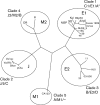A proposal for a common nomenclature for viral clades that form the species varicella-zoster virus: summary of VZV Nomenclature Meeting 2008, Barts and the London School of Medicine and Dentistry, 24-25 July 2008
- PMID: 20071486
- PMCID: PMC2888159
- DOI: 10.1099/vir.0.017814-0
A proposal for a common nomenclature for viral clades that form the species varicella-zoster virus: summary of VZV Nomenclature Meeting 2008, Barts and the London School of Medicine and Dentistry, 24-25 July 2008
Abstract
Varicella-zoster virus (VZV), the cause of chickenpox and zoster, was the first human herpesvirus to be sequenced fully and the first for which vaccines have been licensed and widely used. Three groups have published genotyping schemes based on single nucleotide polymorphisms (SNPs) and, between them, have identified five distinct phylogenetic clades, with an additional two putative clades. Sequencing of over 23 whole VZV genomes from around the world further refined the phylogenetic distinctions between SNP genotypes. Widespread surveillance in countries in which the varicella vaccine is now in use and the difficulties posed by three unique genotyping approaches prompted an international meeting, at which a common nomenclature based on phylogenetic clades was agreed upon. In this paper, we review the original genotyping schemes and discuss the basis for a novel common nomenclature for VZV strains. We propose a minimum set of SNPs that we recommend should be used to genotype these viruses. Finally, we suggest criteria by which novel clades can be recognized.
Figures



References
-
- Barrett-Muir, W., Hawrami, K., Clarke, J. & Breuer, J. (2001). Investigation of varicella-zoster virus variation by heteroduplex mobility assay. Arch Virol Suppl 17, 17–25. - PubMed
-
- Brookes, A. J. (1999). The essence of SNPs. Gene 234, 177–186. - PubMed
-
- Collins, F. S. (1997). Sequencing the human genome. Hosp Pract (Minneap) 32, 35–54. - PubMed
-
- Dangler, C. A., Henderson, L. M., Bowman, L. A. & Deaver, R. E. (1993). Direct isolation and identification of recombinant pseudorabies virus strains from tissues of experimentally co-infected swine. Am J Vet Res 54, 540–545. - PubMed
Publication types
MeSH terms
Grants and funding
LinkOut - more resources
Full Text Sources

